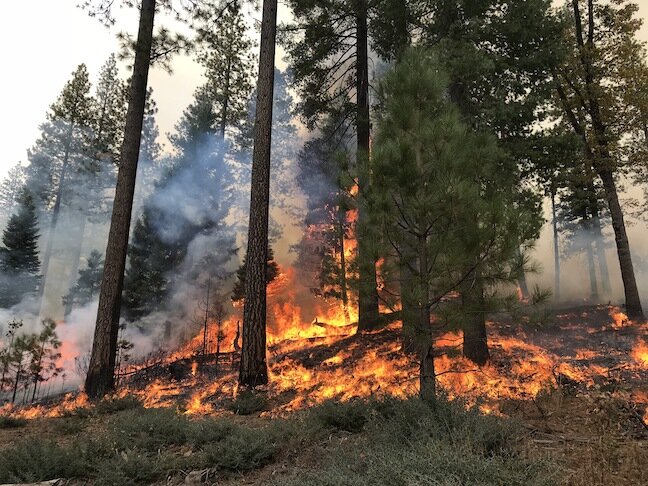Paradigm Shifting Policy


Partnerships, conservation finance, and the Forest Resilience Bond (FRB) are key drivers of the paradigm shift needed to adequately address the forest restoration backlog.
Written by: Blue Forest Policy Director, Mac Cloyes
Former US Forest Service (USFS) Chief Vicki Christiansen explained, during her final hearing as Chief, “the 2020 fire year became a call to action. We saw the most acres burned on Forest Service lands since the big burn of 1910. We must have a paradigm shift.” In August, newly appointed USFS Chief Randy Moore told ABC’s Good Morning America that the agency must do four times more annual hazardous fuels treatments to mitigate wildfire risk. Federal funding is an integral component to the required paradigm shift and quadrupling of treatments, but funding increases must be complemented by the right tools to ensure successful implementation and long-term viability.
Partnerships, conservation finance, and the Forest Resilience Bond (FRB) are key drivers of the paradigm shift needed to adequately address the forest restoration backlog. These tools add financial and human resource capacity, while enabling those who benefit from forest restoration to participate in the solution at a landscape scale. This results in more work getting done, faster, at a lower cost to the federal government and participating stakeholders. Public-private partnerships like the FRB finance projects, while aligning payment streams with co-benefits and removing capacity-related bottlenecks that would otherwise inhibit the agency’s ability to efficiently deploy large increases in funding. There is significant potential to increase the pace and scale of forest restoration with the FRB. Importantly, the FRB can help ensure restoration continues at appropriate levels beyond near-term increases in federal funding.
There are currently two potential sources for a substantial increase in USFS funding being considered by Congress. The Infrastructure Investment and Jobs Act would provide over $5 billion across multiple restoration and non-restoration focused USFS programs over five years. The House Committee on Agriculture recently marked up their reconciliation proposal, which would provide $40 billion to the agency over 10 years, of which $14 billion would go towards hazardous fuels treatments. This funding would significantly improve the agency’s ability to increase the pace and scale of forest restoration to reduce the risk of catastrophic wildfire, and we must work to ensure long-term viability to avoid potential pitfalls of a boom-bust cycle in forest restoration funding.
While Blue Forest has demonstrated that FRBs can and will continue to be implemented under current federal law, there are opportunities to make relatively minor legislative and policy changes to better enable land managers to access larger amounts of private capital to restore forests at an appropriate pace and scale. At Blue Forest, we are concurrently developing and implementing projects while we work with our partners, USFS, and Congress on legislative and policy solutions to help land managers implement larger forest restoration projects.
A recent report by The Nature Conservancy highlights the importance of innovative approaches, including the Forest Resilience Bond, that enable private investment and partnerships to support wildfire resilience projects. Among the many sound recommendations in the report, the following five points highlight specific needs and opportunities for conservation finance to help address wildfire risk:
-
Innovative financing could have vast potential for expanding investments in wildfire risk reduction. Environmental Impact Bonds and other financing vehicles are a logical tool for coordinating treatment strategies across multi-owner, multi-stakeholder landscapes.
-
In the near term, efforts should focus on expanding funding for early-stage project development and incubation to expand the number of pilot efforts and continue to demonstrate proof of concept.
-
Realizing the potential for these types of investments requires addressing key structural issues that will likely require changes in agency authority to commit funds over the long run, agency capacity to engage in conservation finance, and agency capacity to design marketable projects for private sector funding.
-
Partners such as the National Forest Foundation, the Forest Service’s National Partnership Office, Blue Forest and others should consider the development of a learning network.
-
In the longer term, efforts should focus on addressing structural impediments to these investments, including new authorities to allow for commitment of federal funds to service bonds and agency capacity for conservation finance across Forest Service units.
As my colleague, Peter Wyrsch, so accurately pointed out in last month’s newsletter, “our take-away is simple: a single policy or funding fix won’t solve the problem of catastrophic wildfire in the west.” As we work to address one of the greatest land management challenges of our time, we must not forget what fire historian Stephen Pyne has spent his career telling us, “our history has been a story of how we and fire have co-evolved. The same holds for our future.” A paradigm shift requires that we continue to expand our field of vision when it comes to forest and fire policy in order to meet the evolving needs of forests and society.